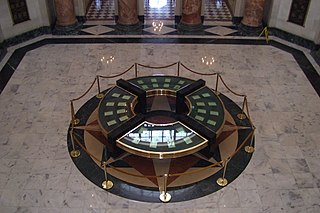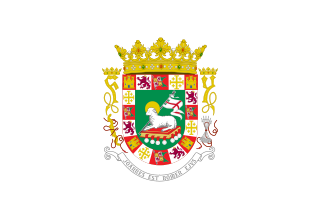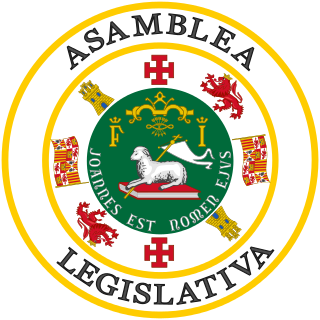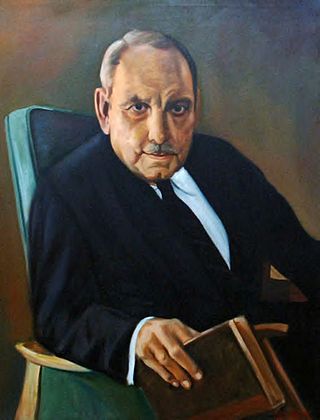
The government of the Commonwealth of Puerto Rico is a republican form of government with separation of powers, subject to the jurisdiction and sovereignty of the United States. Article I of the Constitution of Puerto Rico defines the government and its political power and authority. The powers of the government of Puerto Rico are all delegated by the United States Congress and lack full protection under the U.S. Constitution. Because of this, the head of state of Puerto Rico is the President of the United States.

The Constitution of the Commonwealth of Puerto Rico is the controlling government document of Puerto Rico. It is composed of nine articles detailing the structure of the government as well as the function of several of its institutions. The document also contains an extensive and specific bill of rights. It was ratified by Puerto Rico's electorate in a referendum on March 3, 1952, and on July 25, 1952, Governor Luis Muñoz Marín proclaimed that the constitution was in effect. July 25 is known as Constitution Day.

The governor of Puerto Rico is the head of government of the Commonwealth of Puerto Rico, and commander-in-chief of the Puerto Rico National Guard.

The Senate of Puerto Rico is the upper house of the Legislative Assembly of Puerto Rico, the territorial legislature of Puerto Rico. The Senate, together with the House of Representatives of Puerto Rico, control the legislative branch of the government of Puerto Rico.

The House of Representatives of Puerto Rico is the lower house of the Legislative Assembly of Puerto Rico, the bicameral territorial legislature of Puerto Rico. The House, together with the Senate, control the legislative branch of the government of Puerto Rico.

The Legislative Assembly of Puerto Rico is the territorial legislature of the Commonwealth of Puerto Rico, responsible for the legislative branch of the government of Puerto Rico. The Assembly is a bicameral legislature consisting of an upper house, the Senate normally composed of 27 senators, and the lower house, the House of Representatives normally consisting of 51 representatives. Eleven members of each house are elected at-large rather than from a specific legislative district with all members being elected for a four-year term without term limits.
Federico Hernández Denton was the 15th chief justice of the Supreme Court of Puerto Rico.

The Supreme Court of Puerto Rico is the highest court of Puerto Rico, having judicial authority to interpret and decide questions of Puerto Rican law. The Court is analogous to one of the state supreme courts of the states of the United States and is the highest state court and the court of last resort in Puerto Rico. Article V of the Constitution of Puerto Rico vests the judicial power in the Supreme Court, which by nature forms the judicial branch of the government of Puerto Rico. The Supreme Court holds its sessions in San Juan.

Baltasar Corrada del Río was a Puerto Rican politician. He held various high political offices in the island, including President of the Puerto Rico Civil Rights Commission, Resident Commissioner (1977–1985), Mayor of the capital city of San Juan (1985–1989), Puerto Rico's 15th Secretary of State (1993–1995) and Associate Justice of the Supreme Court (1995–2005). He was also the unsuccessful NPP candidate for Governor in the elections of 1988.

The United States District Court for the District of Puerto Rico is the federal district court whose jurisdiction comprises the Commonwealth of Puerto Rico. The court is based in San Juan. The main building is the Clemente Ruiz Nazario United States Courthouse located in the Hato Rey district of San Juan. The magistrate judges are located in the adjacent Federico Degetau Federal Building, and several senior district judges hold court at the Jose V. Toledo Federal Building and U.S. Courthouse in Old San Juan. The old courthouse also houses the U.S. Bankruptcy Court. Most appeals from this court are heard by the United States Court of Appeals for the First Circuit, which is headquartered in Boston but hears appeals at the Old San Juan courthouse for two sessions each year. Patent claims as well as claims against the U.S. government under the Tucker Act are appealed to the Federal Circuit.

The president of the Senate of Puerto Rico is the highest-ranking officer and the presiding officer of the Senate of Puerto Rico. The president has voting powers as it is elected amongst the own members of the Senate as established by Article III of the Constitution of Puerto Rico. The Constitution, however, does not establish its functions and since the Senate is the only body authorized by the Constitution to regulate its own internal affairs, the functions of the president vary from session to session—save being called "President" as the Constitution establishes. The president is typically elected during the Senate's inaugural session.

The Popular Democratic Party is a political party in Puerto Rico that advocates to continue as a Commonwealth of the United States with self-governance. The party was founded in 1938 by dissidents from the Puerto Rican Liberal Party and the Unionist Party and originally promoted policies on the center-left. In recent years, however, its leaders have described the party as centrist.

The executive branch of the government of Puerto Rico is responsible for executing the laws of Puerto Rico, as well as causing them to be executed. Article IV of the Constitution of Puerto Rico vests the executive power on the Governor—whom by its nature forms the executive branch.
The Judiciary of Puerto Rico is defined under the Constitution of Puerto Rico and consists of the Supreme Court of Puerto Rico, Court of Appeals, and the Court of First Instance consisting of the Superior Courts and the Municipal Courts.

Maite Oronoz Rodríguez is a Puerto Rican jurist who currently serves as the 17th Chief Justice of the Supreme Court of Puerto Rico since 2016. Oronoz Rodríguez is Puerto Rico's first openly gay chief justice.
United States v. Vaello Madero, 596 U.S. ___ (2022), was a United States Supreme Court case related to the constitutionality of the exclusion of United States citizens residing in Puerto Rico from the Supplemental Security Income program. In an 8–1 decision, the Court ruled that as Congress had been granted broad oversight of United States territories by Article Four of the United States Constitution, the exclusion of the territories by Congress from programs like Supplemental Security Income did not violate the Due Process Clause of the Fifth Amendment.

The government of Governor of Puerto Rico Luis Muñoz Marín was that of the first elected governor. In addition to that, it was the first whose cabinet did not receive the advice and consent of the United States Senate, but from the Puerto Rico Senate. This all came as part of the 1947 Puerto Rico Elective Governor Act. During this government, the Puerto Rican people addressed via Puerto Rico Federal Relations Act of 1950's mechanism the creation of their own constitution, which was ratified and enacted in the latter months of the Muñoz Marín government, which reconfigured the system of government by creating the Puerto Rico Council of Secretaries and enlarged the Legislative Assembly's chambers. The Commonwealth of Puerto Rico was established, and the 1952 Commonwealth Constitution is, with some amendments, the current constitution of the archipelago.

This second government of Governor of Puerto Rico Luis Muñoz Marín followed his reelection after the enactment of the 1952 Commonwealth Constitution. In many ways it was a continuation of the previous government, with some changes in key positions such as the Secretary of Justice, and decreased control of the Senate of Puerto Rico and House of Representatives of Puerto Rico by virtue of the expansion of the Legislative Assembly's chambers and the effects of Article III, Section 7 of the Constitution of Puerto Rico (1952).

This third government of Luis Muñoz Marín followed his second reelection. In many ways it was a continuation of the previous government, with some changes in positions such as the Secretary of Justice, Agriculture, and the same amount of supermajoritarian control of the Senate of Puerto Rico and House of Representatives of Puerto Rico, while the opposition composition shifted from being led by the Puerto Rican Independence Party to the Partido Estadista Republicano, their presence bolstered by virtue of the effects of Article III, Section 7 of the Constitution of Puerto Rico (1952).

This fourth and last government of Luis Muñoz Marín followed his third reelection. In many ways it was a continuation of the previous government, with one change in positions, the Secretary of Labor, and the same amount of supermajoritarian control of the Senate of Puerto Rico and House of Representatives of Puerto Rico.

















